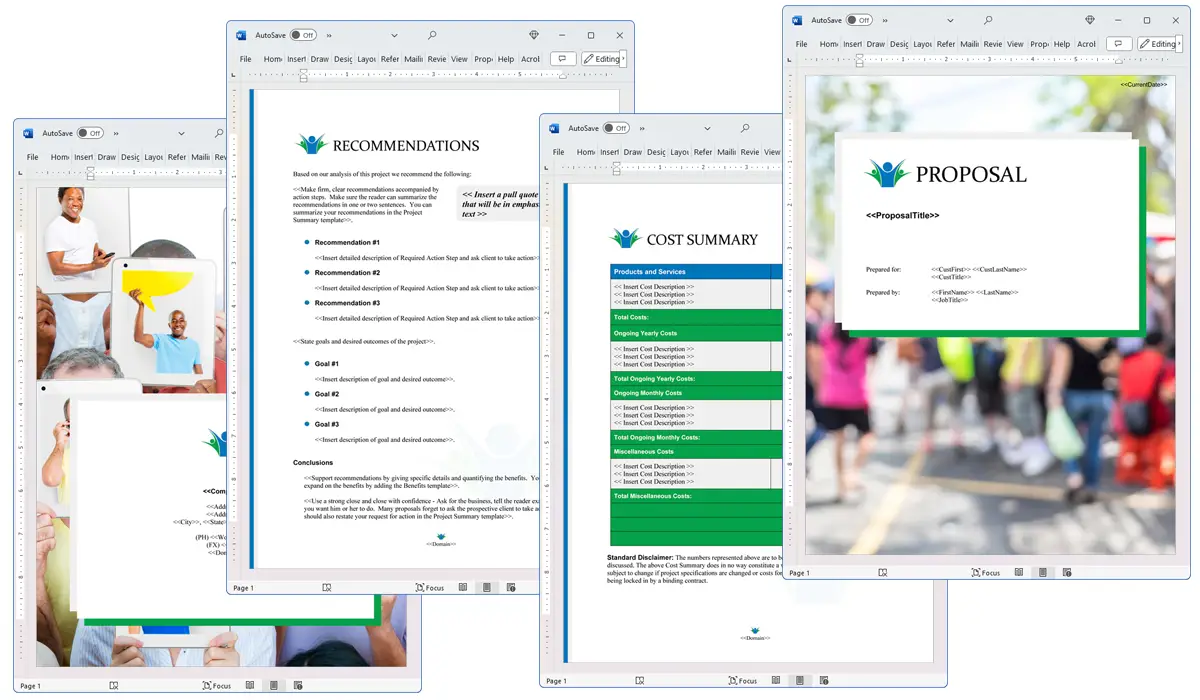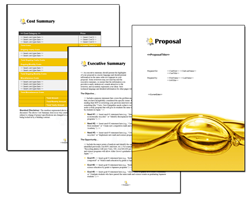What is the Portfolio chapter used for?
Proposal Kit Professional Bundle adds more design themes, all six Contract Packs,
a project management library, and Expert Edition software.

Illustration of Proposal Pack Community #2
We include this Portfolio chapter template in every Proposal Pack, along with thousands more. You assemble this chapter with others in various combinations to create custom-tailored business proposals, plans, reports, and other documents. Proposal Packs apply custom visual designs to the templates, giving the final documents a consistent professional finish.
 DOWNLOADABLE, ONE-TIME COST, NO SUBSCRIPTION FEES
DOWNLOADABLE, ONE-TIME COST, NO SUBSCRIPTION FEES
Overview of the Portfolio Chapter
The Portfolio chapter is an integral part of a business proposal, serving a purpose for companies aiming to secure new projects or clients. This chapter functions as a showcase, presenting a curated collection of past projects that demonstrate the business's capabilities, expertise, and success in relevant areas. Its main goal is to build confidence in potential clients by displaying tangible evidence of the company's accomplishments and alignment with the client's needs.
How is the Portfolio Chapter Used?
In a business proposal, the Portfolio chapter is used as a persuasive tool. It is placed to catch the attention of the reader after the initial introduction and statement of needs. By illustrating the company's previous successful engagements, this chapter strengthens the proposal's argument by bridging past achievements with future potential. It's particularly effective in providing visual and descriptive proof that the business can handle projects similar to what the proposal is targeting.
What is Included in the Portfolio Chapter?
Typically, the Portfolio chapter includes a selection of case studies, images, descriptions, and summaries of relevant projects the company has completed. Each entry is carefully chosen to resonate with the specific requirements and interests of the prospective client. Elements such as project titles, dates, brief descriptions, outcomes, and even testimonials from past clients might be included to enrich the narrative and provide a more comprehensive view of the company's capabilities.
Use Case Examples for the Portfolio Chapter
The Portfolio chapter can be adapted to suit various industries and needs, including but not limited to:
- Web and IT Proposals: Showcasing website designs or software solutions tailored for previous clients.
- Technical and Hardware Solutions: Illustrating the development and deployment of technical equipment or hardware integrations.
- Media and Design Initiatives: Presenting marketing campaigns, branding efforts, or graphic design projects completed for other businesses.
- Employment and Human Resources Services: Demonstrating expertise in staffing solutions or employee training programs.
- Fashion, Image, and Art Projects: Displaying fashion collections, photography work, or art installations created for past clients.
- Resumes and About Your Company: Enhancing proposals for personal career advancement or company introductions with detailed past project descriptions and successes.
Key Takeaways
- Demonstrates Expertise: The Portfolio chapter is crucial for showing proven expertise and building trust with potential clients.
- Customizable Content: It should be tailored to reflect the business's strengths relevant to the client's specific needs and industry.
- Visual and Descriptive: Incorporating both visual elements and detailed descriptions helps to paint a fuller picture of past successes.
- Enhances Persuasiveness: Strategically positioned, it strengthens the proposal's overall argument by linking past achievements with the client's current needs.
- Versatile Application: This chapter can be used across a wide range of industries to highlight a company's breadth and depth of experience.

Illustration of Proposal Pack Energy #10
 What Our Clients Say
What Our Clients SayI have purchased this in the past (twice) for people I have worked for and I’m going to submit a proposal myself since I know how to do the work but Proposal Pack cuts a lot of the labor involved in "explaining" the process."
 4.7 stars, based on 845 reviews
4.7 stars, based on 845 reviewsRelated Chapters
Samples Using the Portfolio Chapter
Document Layouts Using the Portfolio Chapter
- Woodworking Contractor Services Proposal
- Cloud Services Consulting Proposal
- Extensive Technical Proposal
- Wedding Photography and Videography Services Proposal
- Cosmetic Surgery Services Proposal
- Ghostwriting and Authoring Services Proposal
- Commercial Photography Services Proposal
- Photography Services Proposal
- Extensive Non-Technical Proposal
- CD-ROM Development Proposal
- Investment Restructuring to Reduce Risk Proposal
- Graphic Design Proposal Template
- Large Web Site and CD-ROM Project
- Company Rebranding Proposal
- Event Photography Services Proposal
- Fashion Photography Services Proposal
- Artist Gallery Consignment Sales Proposal
- Resume Proposal
- Mobile App Software Development Proposal
- Graphic Designer Proposal
- And more like these

The Portfolio chapter and other chapters are integrated into a Word document as illustrated here in the Proposal Pack Tech #8 design theme. There are hundreds of design themes available, and every design theme includes the Portfolio chapter template.
A proper business proposal will include multiple chapters. This chapter is just one of many you can build into your proposal. We include the complete fill-in-the-blank template in our Proposal Pack template collections. We also include a library of sample proposals illustrating how companies in different industries, both large and small, have written proposals using our Proposal Packs. This template will show you how to write the Portfolio.
We include a chapter library for you to build from based on your needs. All proposals are different and have different needs and goals. Pick the chapters from our collection and organize them as needed for your proposal.
Using the Proposal Pack template library, you can create any business proposal, report, study, plan, or document.
 Ian Lauder has been helping businesses write their proposals and contracts for two decades. Ian is the owner and founder of Proposal Kit, one of the original sources of business proposal and contract software products started in 1997.
Ian Lauder has been helping businesses write their proposals and contracts for two decades. Ian is the owner and founder of Proposal Kit, one of the original sources of business proposal and contract software products started in 1997.By Ian Lauder
 Published by Proposal Kit, Inc.
Published by Proposal Kit, Inc.Your perceived ability to be able to complete a project may be based on what you have done in the past. You should show your client as much information directly applicable to their situation as possible that you have done in the past.



 Cart
Cart
 Facebook
Facebook YouTube
YouTube X
X Search Site
Search Site